

| 2 Morpho-Phonology | 7a Using Affixes | 12 The Number System | |
| 3 Basic Morphology | 7b Using Affixes (continued) | The Lexicon | |
| 4 Case Morphology | 8 Adjuncts | Revised Ithkuil: Ilaksh |
| 2.1 Grammatical Typology | 2.5 Vocalic Mutation |
| 2.2 Root and Stem Formation | 2.6 Parts of Speech |
| 2.3 Semantic Instantiation of Stems | 2.7 Affixes |
| 2.4 Consonantal Mutation | 2.8 Note On Terminology |
Morpho-phonology refers to how a language uses its phonemes (meaningful sounds) and phonological features (e.g., stress, tone, etc.) to generate patterns for word-formation and for morphological categories (e.g., singular versus plural, verb tense, etc.) to be applied to words.
The general method in which a language structures its morpho-phonology determines what is known as its grammatical type. There are generally four distinct grammatical types: analytic, agglutinative, synthetic, and polysynthetic.
Analytic languages (also called isolating languages) rely on separate individual function words such as prepositions, determiners and auxiliaries to morphologically manipulate root nouns and verbs. Example languages are Chinese and Vietnamese.
Agglutinative languages rely upon affixes (e.g., prefixes, suffixes) added one-by-one onto roots to morphologically manipulate words. Example languages are Turkish, Japanese, Swahili, and Esperanto.
Synthetic languages (also called fusional, flexional, or inflecting languages) manipulate word roots via internal phonetic manipulation and/or via affixes which function in multiple functional roles (known as “portmanteau” affixes). Examples are Latin, Russian, and Sanskrit.
Polysynthetic (sometimes called incorporating) languages generally do not have pre-designated words, but rather join together semantic-formative elements in sequential fashion, each resulting “string” constituting a single word conveying an entire sentence of information. Examples are Inuit (Eskimo), Shawnee, and many other American Indian languages, as well as several Paleo-Siberian languages.
Many languages rely upon a mixture of the above in their morpho-phonology. For example, the Romance languages (Spanish, French, Italian, etc.) are primarily analytic, secondarily synthetic, and occasionally agglutinative. On the other hand, English is primarily analytic, secondarily agglutinative, and occasionally synthetic.
Ithkuil morpho-phonology is primarily synthetic and secondarily agglutinative. That is, the manner in which morpho-semantic stems, inflections and derivations are formed, and how those elements combine meaningfully into words, is primarily via phonetic modification of the word stem itself and secondarily via affixation. Specifically, Ithkuil morpho-phonology utilizes both consonantal and vocalic mutation, shifts in syllabic stress and tone, and many different kinds of affixes, including prefixes, suffixes, infixes and interfixes.
For example, shown below is an analytical breakdown of the
Ithkuil word ![]() (Listen:
(Listen:
![]() ).
The stem of this word, ciùk
).
The stem of this word, ciùk![]() ,
meaning ‘derived product of a ewe,’ has been completely transformed
into the nearly unrecognizable form
,
meaning ‘derived product of a ewe,’ has been completely transformed
into the nearly unrecognizable form ![]() ,
all due to the systematic mutation of its consonants and vowels. To this stem,
are then added the prefix eu-,
an infix -w-,
and the affix -[V1]t’,
where [V1] represents a vowel increment to be determined
by other morphological factors. As a result the simple root is transformed into
a word containing no less than eleven morphemes (i.e., eleven semantically distinct
word-components). These eleven morphemes and the mutation and affixation process
by which they combine to create this word can be analyzed as follows:
,
all due to the systematic mutation of its consonants and vowels. To this stem,
are then added the prefix eu-,
an infix -w-,
and the affix -[V1]t’,
where [V1] represents a vowel increment to be determined
by other morphological factors. As a result the simple root is transformed into
a word containing no less than eleven morphemes (i.e., eleven semantically distinct
word-components). These eleven morphemes and the mutation and affixation process
by which they combine to create this word can be analyzed as follows:
![]()
![]() =
=
Morphological
Category |
Specific
morpheme |
Shown
by: |
| STEM: | ciùk = “derived product of ewe” |
|
| Perspective: | ABSTRACT | (preantepenultimate stress) |
| Affiliation: | COALESCENT | (prefix eu- in conjunction with TERMINATIVE extension) |
| Extension: | TERMINATIVE | (prefix eu- in conjunction with COALESCENT affiliation) |
| Configuration: | COHERENT | (Grade 7 mutation of C1 radical) |
| Focus: | POSITIVE FOCUS | (-w- infix immediately following C1 radical) |
| Designation: | FORMAL | (Form II of root-vowel mutation) |
| Essence: | REPRESENTATIVE | (Secondary Mode of root-vowel mutation) |
| Case: | REFERENTIAL | (Series E root-vowel mutation + Grade 4 mutation of C2 radical) |
| Context: | AMALGAMATE | (high tone) |
| Affix: | V1t’- (8th degree) = specific derivation of stem (in this case: "ewe's wool") |
APPROXIMATE TRANSLATION: “concerning a hypothetical diminishing in everything having to do with ewe-wool clothing”
All words in Ithkuil which translate into English as nouns or verbs are based on a monosyllabic or disyllabic stem, which in turn derives from an semantically abstract root. This process is explained in the sections below.
The root in Ithkuil forms the semantic basis from which actual noun/verb stems are derived. The root consists of a combination of two consonantal forms, C1 and C2, each of which we will call a radical. Together they create an interfix, that is, an affix consisting of two parts, between which some other morpho-phonological element is infixed (i.e., inserted). We will see that it is vowels that will be infixed between the two radicals, . These radicals can consist of a single consonant or a biconsonantal conjunct (i.e., made up of two consonants). There are 60 possible forms for C1 and 60 possible forms for C2, giving a total of 3600 possible roots. Examples of these C1 + C2 radical interfixes are shown below.
|
p
+ x |
tr
+ c’ |
ks
+ |
xl
+ |
The root is the basic semantic unit in Ithkuil. For example, the radical interfix t+r is a root whose semantic referent is NAME/DESIGNATION. To generate functional word-stems (or simply stems) from the roots, vowels are infixed into the C1+C2 radical interfix. For example, a vowel such as a would be infixed into the radical interfix t+r to give the stem tar, an Ithkuil word for ‘name.’ The manner in which such vowels are infixed into radical interfixes to form stems is entirely systematic but quite complex. It is described in the next several sections.
The Ithkuil semantic root described in the previous section, in turn diversifies into stems which are the actual bases of words in Ithkuil. Furthermore, the stems of each root in turn divide into different Forms, Modes and Patterns, all of which change the actual vowels infixed into the root. These different vowel patternings for each stem are used to help differentiate the complex array of morphological categories available to any stem. The specifics of how Form, Mode, and Pattern operate for each stem are discussed below.
There are three stems associated with each root. It is at the level of stem that Ithkuil roots become actual words with instantiated meaning. Each stem in turn manifests itself in three separate Patterns, which in turn come in two Forms. Furthermore, this array of Pattern and Form is duplicated within a two-fold framework called Mode. Thus, each stem has twelve different vowel patternings associated with it, as shown in Table 5 below.
Table 5: Vocalic Infixes for Stems
by Mode, Pattern and Form
| Primary
Mode |
Secondary
Mode |
||||||
| Pattern
1 |
Pattern
2 |
Pattern
3 |
Pattern
1 |
Pattern
2 |
Pattern
3 |
||
Form
I |
stem
1 |
a |
e |
ä |
aî |
eì |
aì |
| stem
2 |
u |
o |
ö |
uî |
oi |
uì |
|
| stem
3 |
i |
ë |
ü |
eî |
oì |
ëì |
|
Form
II |
stem
1 |
â |
ê |
ae |
aû |
aè |
aù |
| stem
2 |
û |
ô |
ø |
oû |
où |
ëù |
|
| stem
3 |
î |
ÿ |
iu |
eû |
eù |
iù |
|
The three patterns are labelled Pattern 1, Pattern 2, and Pattern 3. Pattern is used to divide a stem into a tripartite grouping consisting of a holistic stem and two complementary sub-stems. An example would be the holistic stem spouse, with its two complementary sub-stems husband and wife. This distinction of holistic versus complementary patterns is one way in which Ithkuil systematizes at the morphological level what in other languages constitute lexical distinctions (i.e., differences in word-choice when translating). It is one of the many ways by which Ithkuil can function fully as a conceptually sophisticated and subtle language while having such a small number of semantic word roots.
The two forms are labelled Form I and Form II. In Section 3.7 we will see how Form is used to indicate a morphological category called Designation. Designation is an important concept, in that, like Pattern above, it operates to make morphological distinctions within a stem that, in languages like English, often entail lexical differences, e.g., the difference between English tool versus utensil.
Lastly, there are two modes, labelled Primary and Secondary. Mode is used to signify a rather complex morphological category called Essence, detailed in Section 3.8. It differentiates “alternate” versions of entities within hypothetical, imagined, or representational contexts, which would otherwise be contradictory or nonsensical. An example would be the word ‘boy’ in the sentence The brown-eyed boy had blue eyes (e.g., in the newspaper account). A stem’s Essence category does not change its underlying meaning.
We can now examine how each root instantiates meaning into the above array of stems. First of all, because Mode distinguishes a morphological category (Essence) that does not change a stem’s underlying meaning, it will be ignored in the analysis below. We will start with the six stems (three for each Form) associated with Pattern 1; these are the holistic stems. This will be followed in a subsequent section by an analysis of the twelve stems associated with Patterns 2 and 3, the complementary stems.
The three stems for Form I, Pattern 1, have the designated vowels a, u, and i. Thus, the previously mentioned root t+r generates the following stems:
1. tar ‘name of something or someone; to name something or someone’
2. tur ‘designation or reference; to assign a designation, to refer to something’
3. tir ‘a (temporary or informal) reference, “nickname”; to give a (temporary or informal) reference or name to, to (temporarily) nickname’
The semantic relationship between each stem and the underlying root is specific to each root. Nevertheless, certain patterns are common. Stem 1 usually refers to the most fundamental, basic, generalized, or common manifestation of the root concept, while Stem 2 is a more specific application or tangible manifestation thereof, or otherwise a subset of the meaning of Stem 1. Stem 3 may represent yet a further manifestation of the root, a further subset of Stem 1, or a tangential or related concept. For example, compare the relationship between the individual stems for the root t+r above with that of the Form I root x+n (‘VISION/SIGHT’) below.
1. xan ‘a sighting, an act of seeing something; to see something’
2. xun ‘an eye; to be an eye/become an eye/use one’s eye, etc.’
3. xin ‘an image in one’s mind; to visualize, to picture in one’s mind’
Note that each stem carries both a nominal (noun) and a verbal meaning. This will be important later when we discuss parts of speech and nominal/verbal morphology. It should also be noted that the meanings given for the verb forms above are approximate and incomplete, as we will see later that the exact meaning of a verb form in Ithkuil is determined by the important morphological categories of Conflation, Derivation and Format (see Section 5.4).
Looking at the Form II counterparts of the above two roots below shows a difference in meaning from the Form I stems as determined by the morphological shift in Designation earlier described. While Form I implies a temporary, contextual interpretation, Form II implies a permanent, authoritative interpretation beyond the mere context of a specific utterance. Note that the vowel infixes associated with the three stems of Form II are â, û, and î, as shown above in Table 5.
1. târ ‘title; to (be) title(d)’
2. tûr ‘formal designation, label; to label’
3. tîr ‘formal role; to function in a formal role’1. xân ‘visual observation; to visually observe’
2. xûn ‘optical device; to use an optical device’
3. xîn ‘a rendered image; to render an image’
Any Ithkuil stem is capable of being further broken down into two complementary stems which represent mutually exclusive component parts of the main stem. Many Ithkuil stems which translate common English nouns and verbs are, in fact, such complementary derivatives, rather than being holistic word-stems.
By “complementary” is meant that the manifestation of a concept appears in any given context as either one sort of entity or another, but never both simultaneously; yet, neither manifestation can be considered to be a discrete contextual whole without the existence of the other. In Ithkuil, for example, words such as male, night, speech, sit, and happen are not considered basic concepts, but rather are parts of greater holistic concepts, existing in complementary relationship to another part, the two together making up the whole.
Thus, Ithkuil lexical structure recognizes that the word male has no meaning in and of itself without an implicit recognition of its complementary partner, female, the two words mutually deriving from a more basic, holistic concept, translatable into English as living being. Similarly, the word night(time) derives along with its complement day(time) from the underlying concept translatable as day (i.e., a 24-hour period), while the concept of speak(ing) divides into complementary concepts of talking (focusing on the physical production of oral sound) versus saying/telling (focusing on the communicative content of oral sound).
Actions, too, are not exempt from this principle of complementarity, an example being the relationship between sit and seat; one has no meaning without an implicit and joint partnership with the other, i.e., one cannot sit unless one sits upon something, and whatever one sits upon in turn functions as a seat. Another example involves the word happen or occur, which Ithkuil recognizes as having no real meaning without the attendant implication of consequence or result, the two being complementary components of a holistic concept roughly translatable as event or situation.
2.3.2.1 Using Patterns 2 and 3 to Derive Complementary
Stems. The first complementary stem is derived from the holistic stem
by mutation of the holistic stem vowel from Pattern 1 into Pattern 2, e.g.,
tal ![]() tel, while the second complementary stem is derived by mutation
from Pattern 1 into Pattern 3, e.g., tal
tel, while the second complementary stem is derived by mutation
from Pattern 1 into Pattern 3, e.g., tal
![]() täl. Several examples of complementary stem derivation
are given below:
täl. Several examples of complementary stem derivation
are given below:
Form I examples:
|
|
|
|
Form II examples:
|
|
|
|
2.3.2.2 Complementary Stems in Translation. As illustrated
above, the structure of Ithkuil holistic vs. secondary complementary roots often
neatly parallels English lexical distinctions, e.g., ‘speak/speech’
breaking down into the physical aspect of ‘talking’ versus the communicative
aspect of ‘saying/telling’ or ‘person’ breaking down
into ‘male’ and ‘female.’ However, it is often the case
that this principle of complementarity creates a semantic situation which is
counterintuitive to Western semantic notions.
For example, let us analyze the root h+n ‘NUCLEAR FAMILY MEMBER’. While most languages would consider the concept parent as fundamentally opposite from the concept child and assign separate word-roots to each, Ithkuil recognizes that one implies the other. No person can be a parent unless they've had a child, just as any child must have (or have had) parents. This, then, constitutes an archetypal complementary relationship, the whole two-sided nature of which is referred to by the holistic stem han. One way to interpret the meaning, then, of han is to say that the word means both ‘parent’ and ‘child,’ which of course strikes a Westerner as being problematical, perhaps even non-sensical. But in fact, the word does not mean either ‘parent’ or‘ child,’ but rather a person who is one of the members of a parent-child relationship, i.e., a member of a nuclear family. With such a root, Stem 2 and Stem 3 in turn subdivide Stem 1 into the further complementary derivatives of male and female. Such “bi-level” derivations of complementary concepts using Stem 2 and Stem 3 are common in Ithkuil root/stem derivation. Here then are the actual meanings of the stems for h+n in Form I.
Holistic
Stem |
1st
Complementary Stem |
2nd
Complementary Stem |
|
| Stem 1 | han: nuclear family member | hen: parent | hän: child |
| Stem 2 | hun: male nuclear family member | hon: father | hön: son |
| Stem 3 | hin: female nuclear family member | hën: mother | hün: daughter |
Additional conceptual complementary pairs which would be contained within single Ithkuil lexical roots are illustrated by the following examples:
| Holistic
Concept |
Complementary
Concepts |
|
| eating | food | ingestion |
| think, act of thinking | a thought (thing considered) | process of consideration |
| liquid | fluid (= ontological nature) | wet[ness] (=defining attribute) |
| measuring | a measurement | process of measuring |
| transference of possession | giving | taking |
| traversal between points | coming, arrival | going, departure |
| commercial transaction | buying | selling |
As each of the 3600 roots has six holistic stems (three in each Form) and twelve complementary stems (six in each Form), there are a total of 64,800 possible stems. We have begun to see how the dynamics of Ithkuil morphology and morpho-semantics allow this limited number to permutate into a myriad of imaginative and dynamic forms for application to any semantic context.
Both of the consonantal radicals from Section 2.3.1 above, C1 and C2, are capable of undergoing mutation, that is, shifting to a different consonantal form. The specific rules governing such mutation, however, are quite distinct for C1 radicals as compared to C2 radicals.
As stated earlier, there are 60 forms for radical C1. Each can mutate into eight other forms, giving a total of nine possible manifestations of each C1 radical. These are labelled Grade 1, Grade 2, etc., up to Grade 9. The nine grades of all 60 C1 radicals are shown in Table No. 6 below. As examples, we can examine the nine grades of the C1 radicals k and pl:
k
g
k’

kf
km
kn
çk/
k
çk’/
k’
pl
bl
pr
br
p

b

p

b

bw/by
Table No. 6: C1
Mutation Patterns by Grade
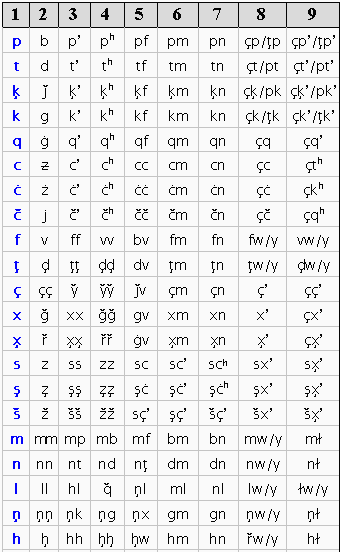 |
 |
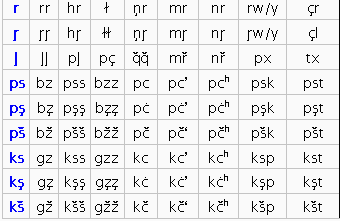 |
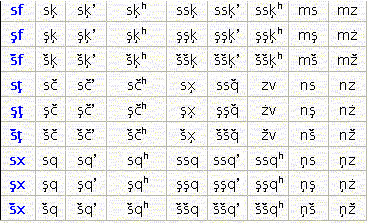 |
As with C1, there are 60 forms of the second radical, C2. These in turn can mutate into eight other forms, for a total of nine possible forms for each C2 radical. These are shown in Table No. 7 below. As an example, note the mutations of the C2 radical t:
t
tt
rt
st
lt

t
št
nt
sst
By combining the above mutational patterns for C1
and C2, along with the various vocalic
mutational patterns we will explore in the next section, we can see that any
given stem can easily mutate into myriad forms which, on the surface, bear scant
visual (or phonetic) resemblance to the original stem.
Table No. 7: C2 Mutation Patterns by Grade
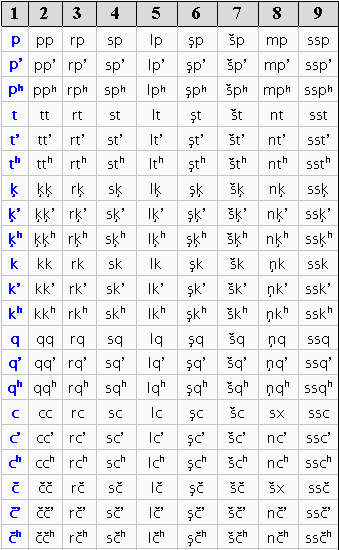 |
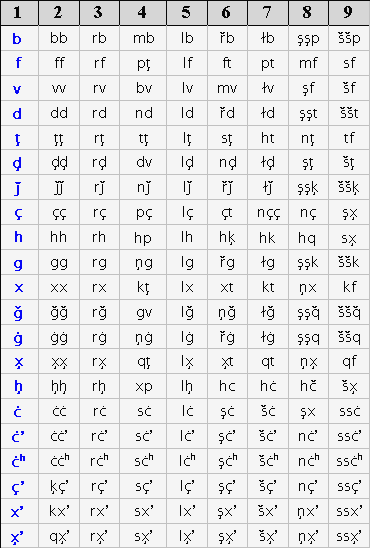 |
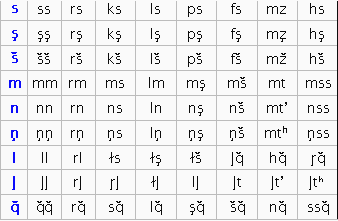 |
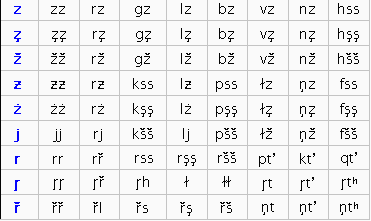 |
In Section 2.2.3 above we saw how the morpho-phonological distinctions of Mode, Form and Pattern are accomplished by stem-specific vocalic infixes as illustrated in Table 5. Like the consonantal C1 and C2 radicals, each of these specific stem-infixes can in turn mutate into eight variations for a total of nine mutations, termed Series A, Series B, Series C, etc. (Note that the ninth series is termed Series J rather than Series I, in order not to confuse the use of ‘I’ as a letter versus a Roman numeral). Consequently each root has a total of 324 different vocalic infixes depending on the Stem, Mode, Form, Pattern, and Series. These series of vowel mutations are shown in Tables 8(a) through 8(f) below, with each table indicating a different combination of Mode and Pattern.
Tables 8(a)-(f): Vocalic
Mutation by Stem, Mode, Pattern, Form and Series
Table 8(a): Primary Mode, Pattern
1
| Series A |
B |
C |
D |
E |
F |
G |
H |
J |
||
| Form I |
stem 1 stem 2 stem 3 |
a u i |
ai ui ei |
a’(ï) u’(ï) i’(ï) |
a’wï u’wï i’wï |
a’wa u’wa i’wa |
a’we u’we i’we |
a’wi u’wi i’wi |
a’wë u’wë i’wë |
a’wo u’wo i’wo |
| Form II |
stem 1 stem 2 stem 3 |
â û î |
au ou eu |
â’(ï) û’(ï) î ’(ï) |
a’yï u’yï i’yï |
a’ya u’ya i’ya |
a’ye u’ye i’ye |
a’yu u’yu i’yu |
a’yë u’yë i’yë |
a’yo u’yo i’yo |
Table 8(b): Primary Mode, Pattern
2
| Series A |
B |
C |
D |
E |
F |
G |
H |
J |
||
| Form I |
stem 1 stem 2 stem 3 |
e o ë |
ia io ie |
e’(ï) o’(ï) ë’(ï) |
e’wï o’wï ë’wï |
e’wa o’wa ë’wa |
e’we o’we ë’we |
e’wi o’wi ë’wi |
e’wë o’wë ë’wë |
e’wo o’wo ë’wo |
| Form II |
stem 1 stem 2 stem 3 |
ê ô ÿ |
ua uo ue |
ê’(ï) ô’(ï) ÿ’(ï) |
e’yï o’yï ë’yï |
e’ya o’ya ë’ya |
e’ye o’ye ë’ye |
e’yu o’yu ë’yu |
e’yë o’yë ë’yë |
e’yo o’yo ë’yo |
Table 8(c): Primary Mode, Pattern
3
| Series A |
B |
C |
D |
E |
F |
G |
H |
J |
||
| Form I |
stem 1 stem 2 stem 3 |
ä ö ü |
ea ië ëi |
ä’(ï) ö’(ï) ü’(ï) |
ä’wï ö’wï ü’wï |
ä’wa ö’wa ü’wa |
ä’we ö’we ü’we |
ä’wi ö’wi ü’wi |
ä’wë ö’wë ü’wë |
ä’wo ö’wo ü’wo |
| Form II |
stem 1 stem 2 stem 3 |
ae ø iu |
oa ëu uë |
ae’(ï) ø’(ï) iu’(ï) |
ä’yï ö’yï ü’yï |
ä’ya ö’ya ü’ya |
ä’ye ö’ye ü’ye |
ä’yu ö’yu ü’yu |
ä’yë ö’yë ü’yë |
ä’yo ö’yo ü’yo |
Table 8(d): Secondary Mode, Pattern
1
| Series A |
B |
C |
D |
E |
F |
G |
H |
J |
||
| Form I |
stem 1 stem 2 stem 3 |
aî uî eî |
a’i u’i e’i |
âì ûì êì |
ai’wï ui’wï ei’wï |
ai’wa ui’wa ei’wa |
ai’we ui’we ei’we |
ai’wi ui’wi ei’wi |
ai’wë ui’wë ei’wë |
ai’wo ui’wo ei’wo |
| Form II |
stem 1 stem 2 stem 3 |
aû oû eû |
a’u o’u e’u |
âù oî êù |
au’yï ou’yï eu’yï |
au’ya ou’ya eu’ya |
au’ye ou’ye eu’ye |
au’yu ou’yu eu’yu |
au’yë ou’yë eu’yë |
au’yo ou’yo eu’yo |
Table 8(e): Secondary Mode, Pattern
2
| Series A |
B |
C |
D |
E |
F |
G |
H |
J |
||
| Form I |
stem 1 stem 2 stem 3 |
eì oi oì |
i’a i’e i’o |
îa îo îe |
â’wï ê’wï ô’wï |
â’wa ê’wa ô’wa |
â’we ê’we ô’we |
â’wi ê’wi ô’wi |
â’wë ê’wë ô’wë |
â’wo ê’wo ô’wo |
| Form II |
stem 1 stem 2 stem 3 |
aè où eù |
u’a u’e u’o |
ûa ûo ûe |
â’yï ê’yï ô’yï |
â’ya ê’ya ô’ya |
â’ye ê’ye ô’ye |
â’yu ê’yu ô’yu |
â’yë ê’yë ô’yë |
â’yo ê’yo ô’yo |
Table 8(f): Secondary Mode, Pattern
3
| Series A |
B |
C |
D |
E |
F |
G |
H |
J |
||
| Form I |
stem 1 stem 2 stem 3 |
aì uì ëì |
e’a i’ë ë’i |
iê îù üa |
û’wï ø’wï î’wï |
û’wa ø’wa î’wa |
û’we ø’we î’we |
û’wi ø’wi î’wi |
û’wë ø’wë î’wë |
û’wo ø’wo î’wo |
| Form II |
stem 1 stem 2 stem 3 |
aù ëù iù |
o’a ë’u u’ë |
aê üe iû |
û’yï ø’yï î’yï |
û’ya ø’ya î’ya |
û’ye ø’ye î’ye |
û’yu ø’yu î’yu |
û’yë ø’yë î’yë |
û’yo ø’yo î’yo |
Ithkuil has only two parts of speech: formatives and adjuncts. While Ithkuil does employ words which function as nouns and verbs, such nouns and verbs derive morphologically from the same grammatical stem (its nominal or verbal function or meaning being dependent on the particular morpho-semantic context), hence the term formative. This process of noun/verb derivation from formatives is discussed in detail in Section 2.6.1 below. Note that there are no adjectives, adverbs, prepositions, pronouns, determiners, conjunctions, particles or interjections in Ithkuil, at least not at any autonomous lexical level that can be termed a part of speech. The equivalents to, or substitutes for, these latter Western grammatical notions all exist within the formative-adjunct morphological paradigm.
Another dissimilarity with Western languages is that there are no irregular or defective forms; all formatives and adjuncts follow the same inflectional and derivational rules without exception and all formatives are theoretically capable of semantic denotation for every inflectional or derivational category, i.e., all inflectionally or derivationally possible words theoretically exist and have meaning (although, in actuality, some forms will, of course, be semantically anomalous, redundant, contrived, or distinguish shades of meaning that are contextually unnecessary).
The stem formed as per the discussion in Section
2.3 above constitutes the grammatical part of speech termed the formative.
All formatives, without exception, can function as both nouns or verbs, and
the distinction as to whether a formative is to be interpreted as a noun or
a verb can only be made by analyzing its derivational morphology and syntactical
relationship to the rest of the sentence. Consequently, there are no stems/formatives
that refer only to nouns or only to verbs as in Western languages. The formative
klâd illustrated above in Section 2.3.2.1 means both
‘river’ and ‘to flow/run (as a river)’ with neither
meaning being seen as more intrinsic or fundamental, nor one deriving from the
other. Such hierarchies of nominal over verbal meaning (or vice-versa) arise
only in translating Ithkuil to English or other Western languages, where such
nominal versus verbal lexical constraints are inherent. Often, the interpretation
or translation of an Ithkuil formative exclusively into a noun or verb form
is arbitrary. For example, the following Ithkuil phrases can be translated using
either verbal predicates or purely nominal phrases:
![]() ______Listen!
______Listen!
![]()
‘by the time of his death’ OR
‘by the time he dies’
![]()
‘the awful-smelling woman’ OR
‘the woman smells awful’
![]() ______Listen!
______Listen!
![]()
‘what the eagle sees’ OR
‘the eagle’s seeing something’
The reason why nouns and verbs can function as morphological derivatives of
a single part of speech is because Ithkuil morpho-semantics does not see nouns
and verbs as being cognitively distinct from one another, but rather as complementary
manifestations of an idea existing in a common underlying semantic continuum
whose components are space and time. As in physics, the holistic continuum containing
these two components can be thought of as spacetime. It is in this continuum
of spacetime that Ithkuil instantiates semantic ideas into lexical roots, giving
rise to the part of speech termed the formative. The speaker then chooses to
either spatially “reify” this formative into an object
or entity (i.e., a noun) or to temporally “activize” it
into an act, event, or state (i.e., a verb). This complementary process can
be diagrammed as follows:
Adjuncts are so named because they operate in conjunction with adjacent formatives to provide additional grammatical information about the formative, somewhat like auxiliary verbs in English (e.g., “may, will, would, do, have”) or like noun determiners (e.g., “the, this, those”).
Adjuncts are formed from one or more consonantal and/or vocalic affixes, combined agglutinatively. There are several different types of adjuncts, most of which are described in detail in Chapter 8: Adjuncts. These include:
Ithkuil makes a fundamental distinction between purely vocalic affixes (i.e., containing no consonants) and affixes which are based on a consonant (which may or may not contain vowels). In this section we will explore consonant-based affixes.
Every consonant-based affix used with a formative is composed of an invariable (i.e., non-mutating) consonant, but has a variable vocalic form associated with it. The suffix form of a consonant-based affix is of the form V+C (i.e., vowel + consonant), with an optional alternate form of C+V when in word-final position and in certain other circumstances. This word-final alternate form is explained in more detail in Chapter 7. As for the optional prefix form of consonantal affixes, this will also be discussed in Chapter 7; the discussion below applies only to the suffix form of affixes.
While the consonantal portion of the affix is always invariable, the vocalic portion mutates depending on two morphological factors known as degree and affix-type. The nine different degrees will be discussed in detail in the next section below. As for affix-type, every consonantal-based V+C (or C+V) affix falls into one of three types, which determine what vowel or vowels will come before (or after) the invariable consonant C. The three affix-types are labelled V1, V2, and V3, in reference to the vowel portion of the affix.
In addition to the three affix-types, the vowel(s) associated with suffixes are also determined by degree. There are nine degrees, each of which has three associated vowel infixes corresponding to the three affix-types. Table 9 below shows the vowel(s) associated with each affix-type.
Under certain circumstances where the final stem consonant and the consonant portion of the consonantal suffix can be conjoined without causing confusion (i.e., where the conjoined consonants will not be mistaken for a mutation of the final consonantal radical C2), Ithkuil permits the option to reverse the order of the vowel and consonant of the suffix. This alternate form is shown in the second column of the table for each degree. In this alternate form, the vocalic portion follows, rather than precedes the consonant portion of the suffix.
Table 9: Vocalic Infixes for Consonantal Suffixes by Affix Type
| Affix
Type 1: -V1C |
Affix
Type 2: -V2C |
Affix
Type 3: -V3C |
||||
standard
form |
optional
reversed form |
standard
form |
optional
reversed form |
standard
form |
optional
reversed form |
|
| Degree 1 | -iC |
-Cai |
-îC |
-Cëi |
-ieC |
-Caï |
| Degree 2 | -eC |
-Cei |
-êC / -eiC |
-Ceu |
-iëC |
-Ceï |
| Degree 3 | -äC / -aeC |
-Cia |
-âC /-aiC |
-Câ |
-iuC |
-Ciï |
| Degree 4 | -öC |
-Cua |
-øC / -euC |
-Ciu |
-ioC |
-Coï |
| Degree 5 | -(a)C |
-Ca |
-uiC |
-Cui |
-iäC |
-Cuï |
| Degree 6 | -üC / -ëuC |
-Cü |
-ÿC / -auC |
-Cau |
-uäC |
-Cäi |
| Degree 7 | -ïC / -ëiC |
-Cï |
-ëC |
-Cëu |
-uoC |
-Cöi |
| Degree 8 | -oC |
-Coi |
-ôC / -oiC / -ouC |
-Cou |
-uëC |
-Cäu |
| Degree 9 | -uC |
-Cu |
-ûC |
-Cû |
-ueC |
-Cöu |
Applying the above rules to three example suffixes we can see in Table 10 below how these suffixes (and their alternate word-final forms) would actually appear in conjunction with the stem rit:
TABLE 10: EXAMPLE OF ALTERNATION
OF VOWEL POSITION IN SUFFIXES
| Suffix:
-V1k |
Affix
Type 2: -V2k |
Affix
Type 3: -V3k |
|
| Degree 1 | ritik / ritkai |
ritîk / ritkëi |
ritiek / ritkaï |
| Degree 2 | ritek / ritkei |
ritêk / riteik / ritkeu |
ritiëk / ritkeï |
| Degree 3 | ritäk / ritaek / ritkia |
ritâk / ritaik / ritkâ |
ritiuk /ritkiï |
| Degree 4 | ritök / ritkua |
ritøk / riteuk / ritkiu |
ritiok / ritkoï |
| Degree 5 | ritk / ritak / ritka |
rituik / ritkui |
ritiäk / ritkuï |
| Degree 6 | ritük / ritëuk / ritkü |
ritÿk / ritauk / ritkau |
rituäk / ritkäi |
| Degree 7 | ritïk / ritëik / ritkï |
ritëk / ritkëu |
rituok / ritköi |
| Degree 8 | ritok /ritkoi |
ritôk / ritoik / ritouk / ritkou |
rituëk / ritkäu |
| Degree 9 | rituk / ritku |
ritûk / ritkû |
rituek / ritköu |
Because the “reversed” -CV form of the suffix reinforces a CVC syllabic structure for the stem syllable of the word, such reversed word-final suffixes are common in Ithkuil (see Sec. 1.4.5).
As for the morpho-syntactic function of Degree, it is used in Ithkuil to create a gradient system for all consonantal affixes, which generally indicates the degree to which the semantic concept underlying the particular affix applies to the particular stem. This gradient usually extends from zero-degree (i.e., the particular concept or quality is absent or minimal) to a maximal degree (i.e., the particular concept or quality is present in totality). We will see in Chapter 7: Using Affixes how this gradient system is used systematically in many dynamic semantic contexts. As a preview we can illustrate the meanings associated with the nine degrees for the affix -V1d.
Degree |
Suffix |
Meaning |
|
1 |
-id / -dai | wholly lacking in / a complete absence of / not at all | |
2 |
-ed / -dei | way too little / totally insufficient(ly) / not anywhere enough | |
3 |
-äd / -aed / -dia | not enough / insufficient(ly) / under-[+verb] | |
4 |
-öd / -dua | not quite enough / somewhat insufficient(ly) / slightly under-[+verb] | |
5 |
-d / -ad / -da | enough (of) / sufficient(ly) | |
6 |
-üd / -ëud / -dü | a little too (much) / more than needed / slightly over-[+verb] | |
7 |
-ïd / -ëid / -dï | too / too much / over-[+verb] | |
8 |
-od /-doi | way too much / totally over-[+verb] | |
9 |
-ud / -du | nothing but / to the exclusion of all else |
Other than the stem-infixes previously discussed in Section 2.3 et seq., the use of vocalic affixes (i.e., affixes based on vowels rather than consonants) in Ithkuil occurs in several contexts — vocalic prefixes to formatives, vocalic prefixes and suffixes to adjuncts, and the anaptyctic affixes -ï-, and -a. Each of these contexts is discussed below:
2.7.3.1 Vocalic Prefixes. Vocalic prefixes are used with both formatives and adjuncts, and consist of either single vowels or two-vowel conjuncts or diphthongs (e.g., a-, ui-, ae-, ia-, ö-, eu-, etc.). Additionally, these prefixes can take an initial w- or y- increment. While these prefixes are often highly synthetic morphologically (i.e., a single prefix can carry information for multiple grammatical categories), they do not mutate. A word can take only one such prefix. The usage and function of these vocalic prefixes will be discussed as they are encountered in the chapters on morphology which follow.
2.7.3.2 Vocalic Suffixes. Purely vocalic suffixes (other than the anaptyctic vowels discussed below) occur only in adjuncts, not formatives. Like vocalic prefixes described immediately above, they can be highly synthetic morphologically but do not mutate. Unlike vocalic prefixes, there can be multiple vocalic suffixes on an adjunct, joined agglutinatively (i.e., added on one after the other) with intervening consonantal affixes.
2.7.3.3 Anaptyctic Vowels -ï- and -a. Sometimes the grammatical rules of a language require a meaningless phonemic increment to be affixed to a word, whether as a prefix, suffix, or infix. This is known as anaptyxis. As will be discussed in Chapter 7: Using Affixes, an anaptyctic infix, -ï-, is used in Ithkuil to separate consonantal prefixes from the C1 stem consonantal radical wherever necessary for phonotactical euphony or to prevent confusion in misinterpreting the prefix consonant(s) as part of the C1 radical. For example, while the prefix s- is phonotactically permissible before the stem kaf, the resulting word must be sïkaf, not skaf, as the latter is a completely different stem employing a C1 radical sk-.
An anaptyctic vowel is also sometimes required in Ithkuil when
grammatical rules call for antepenultimate stress on a word (i.e., the third-from-last
syllable is stressed), but the word in question has only one or two syllables.
In such cases, the number of syllables must be increased to three. Sometimes
this can be done by restructuring any consonantal affixes the word may have,
but more often than not, anaptyctic vowels must be affixed. In this case the
anaptyctic vowel ï- can be prefixed to a word beginning
with a consonant (usually nominal formatives), and/or an anaptyctic vowel -a
can be suffixed to the end of a word, e.g., kfuil
![]() ïkfùila.
This anaptyctic suffix -a is also required for phonotactical
euphony when grammatical rules require the mutation of the second radical C2
to a form which is not permissible in word-final position, e.g., t
ïkfùila.
This anaptyctic suffix -a is also required for phonotactical
euphony when grammatical rules require the mutation of the second radical C2
to a form which is not permissible in word-final position, e.g., t
![]() tt
as in reit
tt
as in reit ![]() reitta.
reitta.
While this chapter has mentioned a few specific morphological categories in passing, beginning with Chapter 3: Basic Morphology, morphological (i.e., grammatical) categories will be discussed in detail. It should be noted that, given the extensive array of overt morphological categories in Ithkuil, the terminology used in naming these categories is often arbitrary. Where a category functions similarly to a familiar linguistic category, the name of that category has been appropriated. Elsewhere, linguistic terminology from Indo-European, Uralic, Amerindian or Ibero-Caucasian grammar has been appropriated out of convenience, often with only a small similarity of function. In still other instances, I have contrived my own grammatical nomenclature.
Proceed to Chapter 3: Basic Morphology >>
| 2 Morpho-Phonology | 7a Using Affixes | 12 The Number System | |
| 3 Basic Morphology | 7b Using Affixes (continued) | The Lexicon | |
| 4 Case Morphology | 8 Adjuncts | Revised Ithkuil: Ilaksh |
©2004-2009 by John Quijada. You may copy or excerpt any portion of the contents of this website provided you give full attribution to the author and this website.